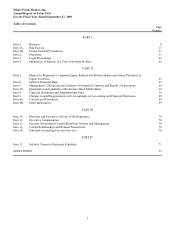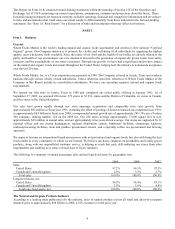Whole Foods 2009 Annual Report Download - page 19
Download and view the complete annual report
Please find page 19 of the 2009 Whole Foods annual report below. You can navigate through the pages in the report by either clicking on the pages listed below, or by using the keyword search tool below to find specific information within the annual report. 13
project is structured, including costs for elements that often increase or decrease rent, e.g., lease acquisition costs, shell
and/or garage costs, and landlord allowances. For stores opened during the past two fiscal years, the average size was 53,200
square feet, and our new store investment averaged approximately $16.3 million excluding pre-opening and relocation
expenses, which averaged approximately $2.7 million per store.
Store Operations
Team Approach to Store Operations
We strive to promote a strong Company culture featuring a team approach to store operations that we believe is distinctly
more empowering of team members than that of the traditional supermarket. Our domestic Whole Foods Market stores each
employ between 25 and 620 team members who comprise up to 13 self-managed teams per store, each led by a team leader.
Each team within a store is responsible for a different product offering or aspect of store operations such as prepared foods,
grocery, or customer service, among others. We also promote a decentralized team approach to store operations in which
many decisions are made by teams at the individual store level. In this structure, an effective store team leader is critical to
the success of the store. The store team leader works closely with one or more assistant store team leaders, as well as with all
of the department team leaders, to operate the store as efficiently and profitably as possible. Each year, our team members are
asked to complete a confidential, third party-administered team leader survey, which provides them with an opportunity to
give their leaders constructive feedback.
We believe our success is dependent on the collective energy and intelligence of all of our team members. We strive to create
a work environment where motivated team members can flourish and reach their highest potential, and where they are
inspired by work that provides them with a greater sense of purpose and mission. For many team members, their job is an
extension of their personal philosophy and lifestyle. Together, we go to great lengths to satisfy and delight our customers.
Voluntary turnover of full-time team members improved from 23% in fiscal year 2008 to 12% in fiscal year 2009, which we
believe is very low for the food retailing industry and allows us to better serve our customers.
Team members are involved at all levels of our business. We strive to create a Company-wide consciousness of “shared fate”
by uniting the interests of team members as closely as possible with the interests of our shareholders. One way we reinforce
this concept is through Gainsharing. Our Gainsharing program rewards things such as labor productivity that team members
can control, giving them a direct stake in the success of our business.
We also encourage stock ownership among team members through the following programs:
• Team Member Stock Option Plan. All full-time and part-time team members are eligible to receive a grant of stock
options each year. The annual grant has two components: (i) Annual Leadership Grants to recognize and incentivize
team member performance; and (ii) Service Hour Grants to recognize team member service to the Company. In
2009 our Board of Directors awarded approximately 2.6 million options to more than 18,800 team members. Of
these stock options, 92% were granted to non-executives, with 45% awarded as Service Hour Grants alone.
• Team Member Stock Purchase Plan. Through biweekly payroll deductions, all U.S.-based non-seasonal team
members with at least 400 service hours may elect to purchase unrestricted shares of our stock at 95% of market
value on the purchase date. The shares are purchased for the plan participants on a quarterly basis.
• Team Member 401(k) Plan. Whole Foods Market stock is an investment option within the Company’s 401(k) plan.
Store Description
We do not have a standard store design model. Instead, each store’s design is customized to fit the size and configuration of
the particular location and community in which it is located. Our culture and philosophy is one of continual innovation and
experimentation, and successful experiments are voluntarily picked up and improved upon by our stores. We strive to
transform food shopping from a chore into a dynamic experience by building and operating stores with colorful décor, well-
trained team members, exciting product mixes, teams of in-store chefs, ever-changing selections, samples, open kitchens,
scratch bakeries, hand-stacked produce, prepared foods stations and European-style charcuterie departments. To further a
sense of community and interaction with customers, our stores typically include sit-down eating areas, customer comment
boards and customer service booths. We have “Take Action” centers for our customers who want to be informed on
important issues related to the environment, legislation, food safety and product quality that can directly affect our
customers’ health and well-being. In addition, some stores offer special services such as massage, valet parking, personal
shopping and home delivery. We believe our stores play a unique role as a third place, besides the home and office, where
people can gather, interact and learn while at the same time discovering the many joys of eating and sharing food.
Purchasing and Distribution
Our buyers purchase products for retail sale from local, regional, national and international wholesale suppliers and vendors.
The majority of our purchasing, particularly in the center store, occurs at the regional and national levels. This enables us to
negotiate better volume discounts with major vendors and distributors, while allowing our regional and store buyers to focus
























